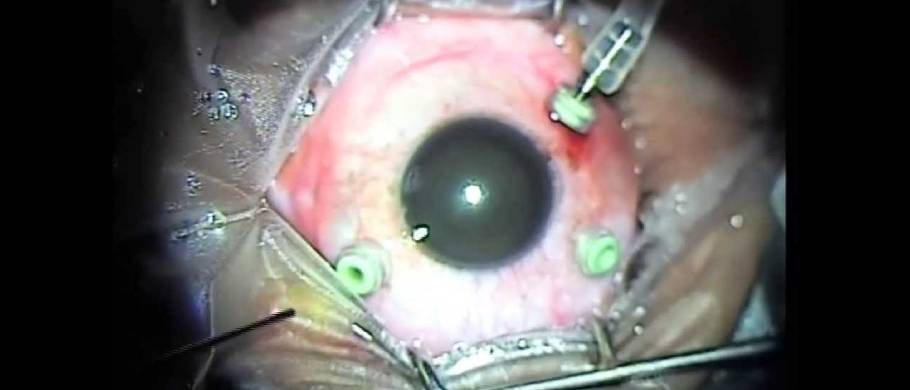Sutureless Vitrectomy Surgery:
Sutureless vitrectomy has rapidly been accepted as an essential part of a vitreoretinal surgical setup. The size and structure of the wound along with near intact conjunctival covering makes the incision self-sealing and safe. This allows the vitrectomy instruments to be used without creating an initial limited peritomy to expose bare sclera, and obviates the need for sutures at the end of the procedure. Wound construction is the essential step in ensuring postoperative wound stability. Both one-step and two-step wound constructions have been described. Key points include an oblique, tunneled approach to ensure a valve-like effect as well as misalignment of conjunctival and scleral wounds by displacing conjunctiva during construction. Advantages include decreased operative times in certain cases and decreased postoperative inflammation, early postoperative rehabilitation, improved patient comfort, and minimal conjunctival damage. Complications are based around wound competence, hypotony, and its relationship to endophthalmitis rates. Early reports highlighted an increase in endophthalmitis though further studies are required to accurately assess the incidence. Endophthalmitis has not been reported in cases that underwent fluid/air exchange. This review focuses on techniques, benefits, complications, personal experiences, and the safety profiles of sutureless vitrectomy systems. A literature review was undertaken using ′Medline′ and ′Pubmed′. Search terms included sutureless vitrectomy, 20 gauge, 23 gauge, 25 gauge, and transconjunctival and small gauge vitrectomy.
Wound construction:

The single most important step for the success of sutureless vitrectomy is the configuration and correct placement of the sclerotomy so as to achieve a self-sealing wound after removal of the cannulae at the completion of surgery. This is achieved by a) creating an oblique wound so as to ensure a valve-like effect similar to clear corneal wounds for phacoemulsification; and b) misaligning the conjunctival and scleral entry sites by displacing the conjunctiva over the scleral surface before creating the wound.
Two types of wound constructions have been described, that is, one-step and two-step incisions. One-step incision involves entry with the sharp trocar with overlying cannula on it, whereas in the two-step procedure, initial entry is first made with the sharp blade and then a cannula is inserted with the help of blunt ended trocar. The one-step incision can be made obliquely perpendicular to the scleral fibers which are arranged in concentric circles near the limbus.13 Alternatively, Shimada et al,14 describe a tunneled scleral incision which is again oblique, but parallel to the limbus. This gives the added theoretical advantage of displacing, rather than cutting the scleral fibers with a reduction in healing time on UBM analysis.13
Two-step incisions offer the advantage of utilizing a sharp instrument for the initial cut; thus, improving the construction of the wound. Oliveira et al,15 reported the use of a 0.7 mm sapphire knife as a variation on the stiletto blade initially used by Eckardt.7 On the other hand, they present the surgeon with a dilemma in that the misalignment of wounds referred to earlier, also creates difficulty in locating the initial entry point for trocar insertion. The two-step incision is also associated with a greater learning curve as compared to a one-step incision.
- 25-guage system and technique
- 23-guage system and technique
- 20-guage system and technique
Benefits:
The benefits of sutureless vitrectomy, regardless of the instrument gauge, are similar to those experienced with sutureless cataract phacoemulsification. A decrease in intraoperative time, patient discomfort (suture and nonsuture related), and postoperative inflammation has been reported.There have also been reports of less surgery induced astigmatism and more rapid visual recovery.
How To Reach Us?
Dr. Nilesh Giri is a trusted Eye Specialist in PCMC, Pune. At Devgiri Memorial Hospital you will get all the necessary medical treatment. Our advanced approach for our patient treatments make us unique.
The appointment process at Devgiri Memorial Hospital PCMC Pune is very simple. You can directly call on 09657002695. Also with the help of the “Book an Appointment” Form you can book your appointment by just filling in the basic information. We will contact you via email or phone call to confirm your appointment.



